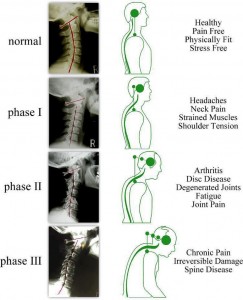Phases of Spinal Degeneration

During the first phase of spinal degeneration, a patient loses the normal curve in the spine, and the disc space slightly changes as well. Because of limited energy flowing through the spinal nerves, joints, discs, and nerves age more quickly. For most people experiencing phase one degeneration, there is little change in the range of motion. 80% of people in phase one have no pain.
Phase 2
During this phase of spinal degeneration patients often notice a large decline in movement and motion, while spinal curvature continues to change. Often times calcium builds up in the spine, which can include spurs and arthritis. Disc spaces narrows and flattens. Those suffering in phase two may notice aches, pains, fatigue and a decrease in height. Another significant development is a narrowing of the spinal canal, known as stenosis. It is amazing at the improvement that can occur during this phase of degeneration with chiropractic treatment. Significant improvement is possible. When left untreated changes in the spine will continue to degenerate with abnormal curvatures, decreasing disc space, restriction of motion and more calcium deposits known as spurs. Posture imbalances become more noticeable, and there may be increased nerve damage and permanent scar tissue. At this point treatment can help a patient from a functional standpoint. Some reversal is possible.
Phase 3
Long term neglect to a spinal subluxation will result in phase 4 degeneration. This phase will dramatically effect the longevity and quality of a person’s life. With years of neurologic damage, a person will experience decreased health, including massive calcium changes, muted disc space, and nearly fused bones. Limited motion results, as well as a myriad of other health issues. Degeneration of this intensity is a serious situation, but is not beyond hope. Patients during this phase have found significant improvements in mobility and quality of life.
